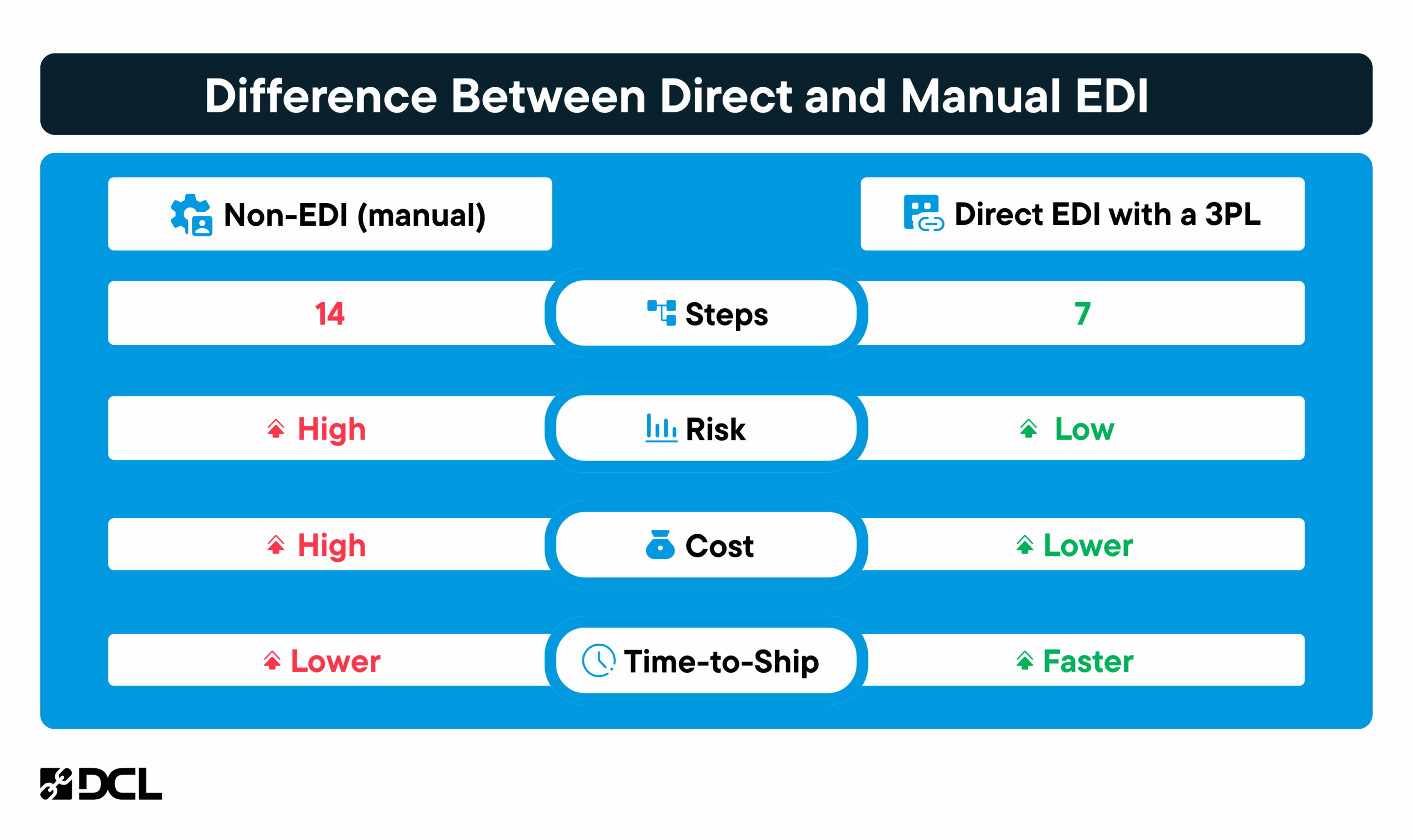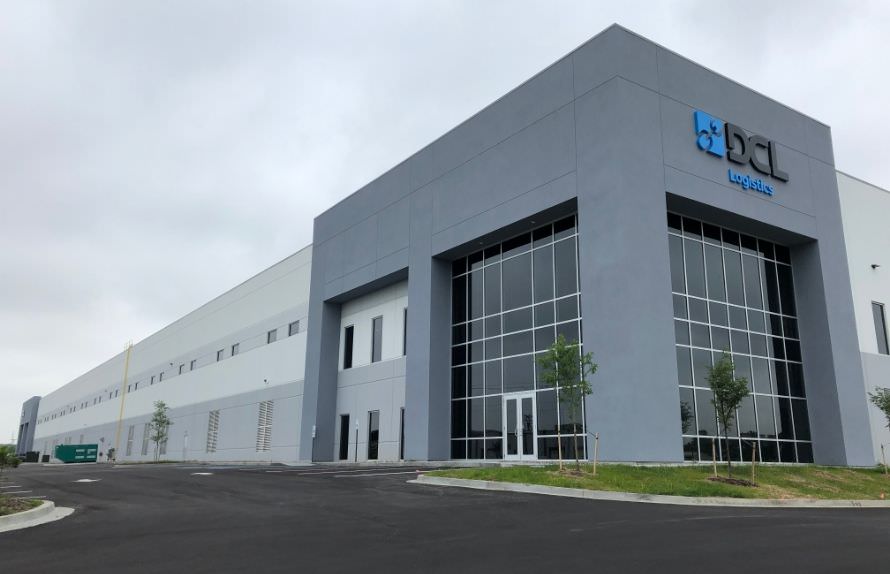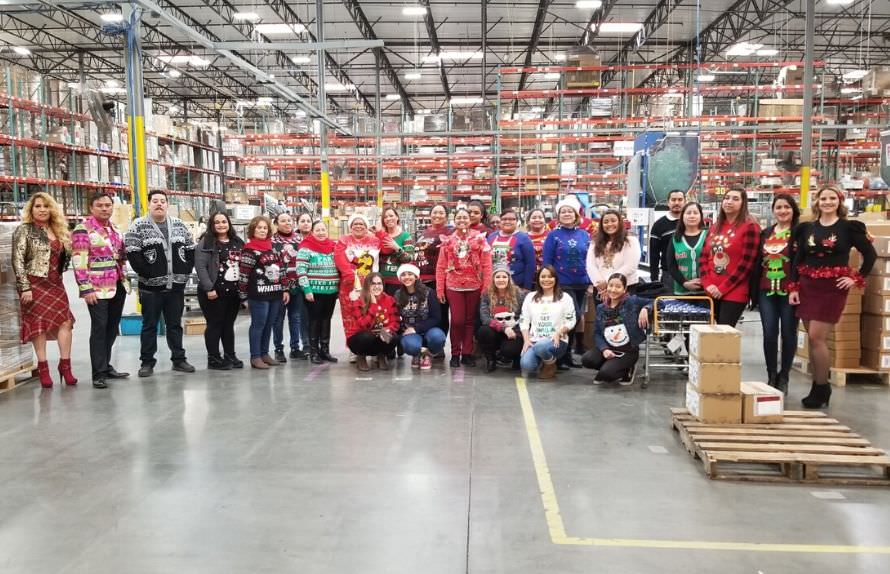
For ecommerce brands entering the world of retail distribution, managing B2B fulfillment can feel like stepping into an entirely different universe. Retailers demand precision: strict ship windows, Must Arrive by Dates (MABDs), compliant labels, accurate ASNs, and real-time visibility into order status.
Many smaller brands handle retail orders manually when they start retail contracts, logging into portals like Amazon Vendor Central, downloading POs, routing shipments, printing labels, and checking compliance line by line. It works early on, but it doesn’t scale.
That’s where direct EDI integration for ecommerce brands becomes a game changer, especially when you partner with a 3PL that’s built for smooth retail fulfillment.
Manual Retail Fulfillment vs. Direct EDI Integration
Without EDI (non-EDI), a typical workflow for an Amazon retail order involves up to 14 manual steps, including updating routing information, reprinting labels, and repeatedly logging into external portals. Anyone in operations knows that every touchpoint introduces risk.
Issues that can arise from manual retail fulfillment include:
- Incorrect product data
- Missed routing windows
- Misapplied or incorrect labels
- Chargebacks for non-compliance
- Labor-draining admin work

While there are still issues that arise using automated retail order processing through EDI, they are far fewer. Orders arrive digitally, shipping labels are generated directly from system data, and ASNs are automatically linked.
Not only is direct EDI more accurate, it can cut processing time in half.

Why Direct EDI is Better for Retail Scale
Retailers increasingly expect brands to support EDI onboarding for retail partners as part of their compliance requirements. Instead of asking your team to log in and out of Vendor Central and hunt for labels, EDI sends everything directly to your fulfillment provider’s systems. They will immediately see orders flow into their WMS; orders will ship out faster and with far fewer exceptions.
1. Operational Efficiency Gains
- 1-piece flow operations, even at scale
- No waiting for label creation
- No multiple logins to retailer portals
- Eliminates manual routing updates
- Faster warehouse execution
2. Potential for Cost Savings
- Less manual labor means lower 3PL handling costs
- Fewer errors lead to fewer chargebacks
- Reduced overhead from retailer portal access fees
3. Error Reduction and Improved Quality
- ASN and carton label data is automated, not typed manually
- Labels are always based on data, which means they are always accurate
- Lower risk of mislabeled shipments and routing mistakes
- Warehouse teams get real-time data to pick, pack, and verify correctly
Better Performance Means Better Retail Relationships
Missing a retailer pickup or shipping delivery window isn’t just a mistake, it’s a huge red flag that can erode retailer trust and lower your performance score. Too many issues can lead to penalties or even suspended selling privileges.
Direct EDI makes it easier to:
- Hit ship windows without begging for extensions
- Avoid order cancellations due to delay
- Maintain retailer scorecards in the green
- Keep inventory flowing to store shelves and distribution centers
For retailers, reliability matters. Retail fulfillment accuracy with EDI shows that your brand is easy to work with and ready to grow.
Direct vs. Indirect EDI: Why It Matters?
Some brands rely on indirect EDI, where a middleware or manual data exchange still requires human involvement. While this is better than manual processing, indirect flows can still introduce delays and errors.
Direct EDI integration for ecommerce brands gives your 3PL the cleanest data possible—with automation across the entire workflow.
How a 3PL Supports Direct EDI Integration
A retail-ready 3PL should have the following processes done, so you don’t have to worry about them:
- Manage mapping and certification for each retail partner
- Test retailer connections before the first PO arrives
- Provide EDI workflow automation for brands
- Handle chargeback prevention and compliance monitoring
- Use real-time data syncing with warehouse operations
This creates a unified system—from retailer, to 3PL, to the final ASN upload back to the retailer’s portal.
Chargeback Prevention: The Hidden ROI
Every mislabeled carton, incorrect UPC, or incorrect routing detail can result in fines. With 3PL EDI integration services, those errors are dramatically reduced.
When you have less risk of errors, you naturally have fewer potential chargebacks. You’ll also save on operational costs with less manual work on your plate.
The ROI becomes clear within the first few months of steady retail volume.
Signs a Brand Should Move to Direct EDI
If you’re moving beyond test quantities, and retail orders become consistent, that’s the best time to go with direct EDI.
A few benchmarks of when direct EDI is right:
- You’re shipping weekly into retail distribution centers
- Retail partners are requesting delivery commitments
- Your team spends hours in retailer portals
- Chargebacks are appearing for admin or labeling errors
- Scaling existing processes feels overwhelming
Brands should always have a roadmap to full EDI; manual processes will work when testing retail channels and proof-of-concept, but they become a liability at scale.
Bottom Line: EDI Is Essential for Efficient Retail Growth
In today’s omnichannel landscape, retail is where growth happens, especially for CPG, beauty, and smaller consumable products. EDI solutions for retail aren’t optional, they’re the infrastructure that supports profitable growth. Direct EDI ensures data accuracy, accelerates order turnaround, eliminates unnecessary labor, and protects retailer relationships.
If you’re working with a 3PL for retail fulfillment, direct EDI isn’t just a technical upgrade—it’s a strategic advantage that helps your brand ship faster, reduce costs, improve quality and scale into more retail channels with confidence.

This post was written by Maureen Walsh, Marketing Director at DCL Logistics. A writer and blogging specialist for 20 years, she helps create quality resources for ecommerce brands looking to optimize their business.
Tags: Omnichannel Fulfillment, Retail Fulfillment








